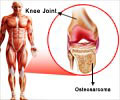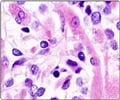- What Is a Soft Tissue Sarcoma? - (https://www.cancer.org/cancer/soft-tissue-sarcoma/about/soft-tissue-sarcoma.html)
- Diseases and condition. Soft tissue sarcoma - (http://www.mayoclinic.org/diseases-conditions/soft-tissue-sarcoma/basics/risk-factors/con-20033386)
- Sarcomas, latest developments in diagnosis and treatment - (http://www.news-medical.net/health/sarcomas-latest-developments-in-diagnosis-and-treatment.aspx)
- Sarcoma, Soft Tissue: Symptoms and Signs - (http://www.cancer.net/cancer-types/sarcoma-soft-tissue/symptoms-and-signs)
What is Soft Tissue Sarcoma?
Sarcomas are rare cancers of the connective tissue and are grouped into two main kinds: soft tissue sarcoma and bone sarcoma, or osteosarcoma. Soft tissue sarcomas affect the tissues that connect, support and surround other body structures and organs; these include muscle, nerves, blood vessels, fat, tendons, tissues around joints and ligaments. Soft tissue sarcomas can develop anywhere in the body but the most common types occur in the abdomen and in the limbs.
What are the Types of Soft Tissue Sarcomas?
There are over 50 different types of soft tissue sarcomas. The more common types include:
- Angiosarcoma: It is a cancer of cells that form the blood vessels and lymph vessels.
- Dermatofibrosarcoma: It develops in the tissue under the skin, commonly found in the trunk or limbs.
- Epithelioid sarcoma: It is generally found in the hands or feet of young adults, appearing as small nodules.
- Ewing’s sarcoma: It can arise from the bones as well as from the soft tissues. When it arises from soft tissue, it is referred to as extraskeletal Ewing’s sarcoma.
- Fibrosarcoma: This type is commonly found in the arms, legs or trunk, but can also be found deeper inside the body. It starts in the fibroblasts that form the fibrous tissue that also envelopes muscles, tendons and ligaments.
- Gastrointestinal stromal tumors (GISTs): These soft tissue tumors develop within the connective tissue present in the walls of the gastrointestinal tract, most commonly in the stomach; rare cases of GISTs arising from outside the digestive tract are also noted. GIST is treated differently from other types of soft tissue sarcomas.
- Kaposi sarcoma: It is a cancer of the blood vessels or lymph system and produces purple plaques on the skin or mucous membranes. Some types of Kaposis sarcoma are known to be associated with AIDS. It is caused by a sexually transmitted virus called human herpes virus 8 (HHV8) or Kaposis sarcoma herpes virus (KSHV).
- Leiomyosarcoma: It is a very common type and starts in the involuntary smooth muscles, such as those found in the intestine, stomach and blood vessels.
- Liposarcoma: It is formed in the fatty tissue and generally shows up as a soft tissue mass.
- Pleomorphic undifferentiated sarcoma: It is formed in the fibrous tissue, most commonly in the legs, but may also occur in the trunk.
- Rhabdomyosarcoma: It is formed in the skeletal muscle and can develop anywhere in the body. Alveolar rhabdomyosarcomas generally occur in the trunk and limbs of younger adults. Anaplastic rhabdomyosarcoma is rare and affects adults while embryonal rhabdomyosarcomas occurs more in children.
- Synovial sarcoma: It is more common in young adults and is most commonly present around large joints and tendons.
- Vascular sarcoma: It develops from the cells that line the inner walls of the blood and lymphatic vessels and includes angiosarcoma, hemangiosarcomas, lymphangiosarcomas and hemangioendothelioma.
- Malignant peripheral nerve sheath tumors (MPNST): These are cancers of the cells that cover nerves. They include neurofibrosarcomas and schwannomas. Schwannomas are the homogenous tumor of the schwann cells that form the fatty sheath covering the nerves.
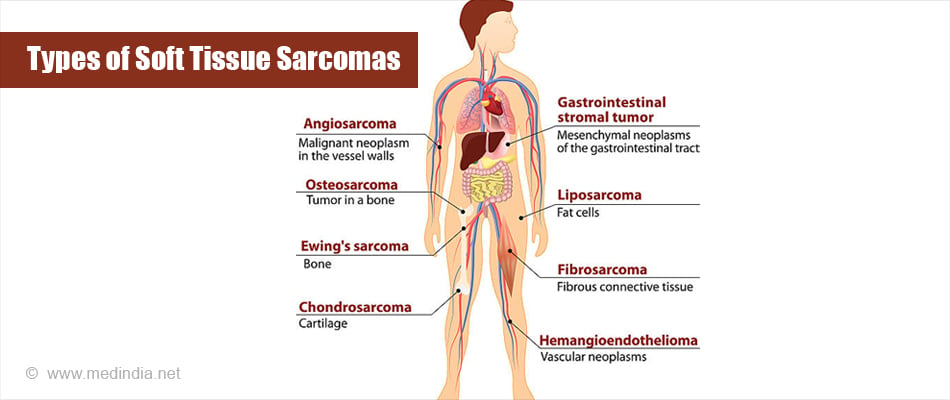
What are the Causes of Soft Tissue Sarcoma?
Unfortunately, in spite of recent advances in molecular and cancer biology, scientists still don't know the exact reason for soft tissue cancers. However, several risk factors have been determined that can make a person more likely to develop these cancers. These risk factors are as follows:
- Certain genetic conditions such as mutations in DNA of cells in the soft tissues are associated with these sarcomas. Generally, these mutations are acquired rather than being inherited and can turn the oncogenes on or turn off tumor suppressor genes.
- Exposure to high doses of radiation such as given during a previous cancer therapy can also give rise to the soft tissue sarcomas.
- Increased risks of sarcoma have also been observed in relation to exposure to certain chemicals, including vinyl chloride, dioxin, and phenoxyacetic herbicides.
- A damaged lymph system: Surgical removal of lymph nodes or damage by radiation therapy causes swelling called lymphedema. Lymphangiosarcoma (a malignant tumor that develops in lymph vessels) is a very rare complication of chronic lymphedema.
However, in some types, the reasons causing soft tissue sarcomas have been identified. For example, Kaposi's sarcoma is caused due to the human herpesvirus 8.
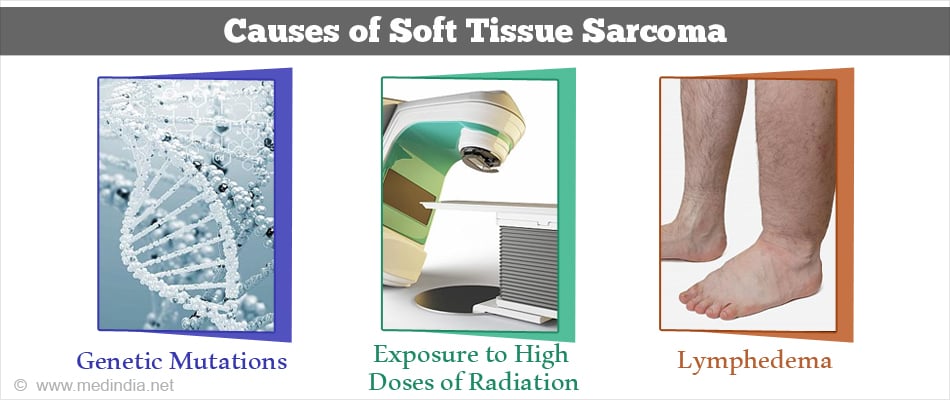
What are the Symptoms of Soft Tissue Sarcomas?
Generally, soft tissue sarcomas don’t have clear symptoms in the initial stages but can cause symptoms once they become bigger and start spreading. The symptoms depend on where the cancer develops.
- If the sarcoma is under the skin, it may cause a soft, painless lump that cannot easily be moved around and gets bigger over time. However, most of the lumps are not sarcomas, they are lipomas which are benign swellings made of fat cells and will stay for many years without growing in size. If the size of the lump is bigger than 2 inches (5 cm), or grows larger, or is painful, regardless of its location, one should consult a doctor.
- If the cancer is near the stomach, it may cause abdominal pain, a persistent feeling of fullness and constipation.
- If the sarcoma is near the lungs, it may cause cough or breathlessness.
- As soft tissue sarcomas develop in flexible, elastic tissue, they can grow and become large before they produce symptoms. Sometimes the growing tumor will cause too much of pain.
How do You Diagnose Soft Tissue Sarcomas?
Diagnosis of soft tissue sarcomas first involves the physical examination of the lumps. If the size of the lump is bigger than 2 inches, is painful or growing larger, the doctor will advise you to go for imaging tests.
Imaging tests -These tests are done to look for the cause of symptoms and to detect a tumor.
- Plain X-Ray: First a regular x-ray of the area with the lump will be done. If you are diagnosed with sarcoma, the doctor will ask for chest x-ray to see if the sarcoma has spread to the lungs.
- Computed tomography (CT) scans: If a soft tissue sarcoma is suspected in the chest, abdomen or the retroperitoneum region, a CT scan is often performed. The CT scan is also used to check the spread of a diagnosed sarcoma to lungs, liver and other organs.
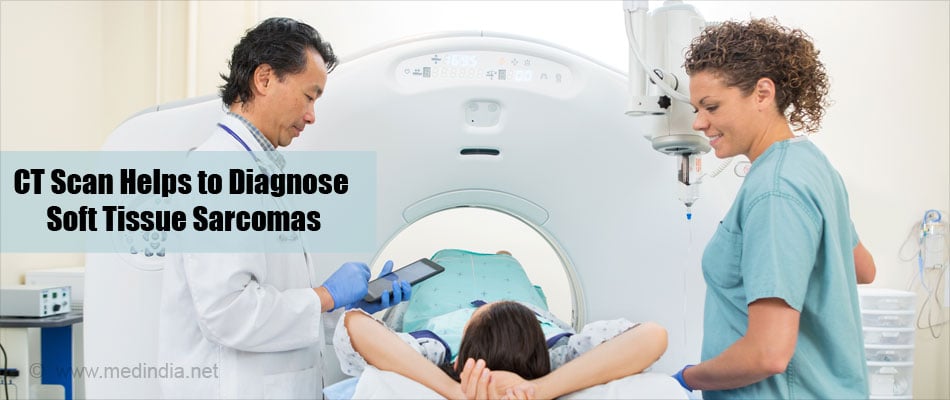
- Magnetic resonance imaging (MRI) scans: MRIs are often better than CT scans in evaluating sarcomas in the arms or legs as they provide a better idea about the location, size, extent of the tumor and sometimes the type of tissue affected. MRIs also help in planning a biopsy.
- Ultrasound: Ultrasound may be done before a biopsy to see if the lump is a cyst, meaning if it has fluid and is likely benign, or if it is solid and more likely to be a tumor. This is generally not needed if a CT or MRI was performed.
- Positron emission tomography (PET) scan: A PET scan is used to check the spread of the sarcoma as it scans the whole body. It is generally used with a CT scan to check if abnormalities seen on the CT scan are cancer or something else.
Biopsy
If the physical and imaging tests hint at a possible sarcoma, the doctors generally perform a biopsy procedure. Several types of biopsies are used to diagnose sarcomas based on the size and location of the tumor.
- Fine needle aspiration (FNA) biopsy is done to withdraw small pieces from the tumors. It helps in confirming whether the mass is a sarcoma or another type of cancer, a benign tumor, an infection, or some other disease.
- Core needle biopsies use a bigger needle and remove a cylindrical piece of tissue.
- In a surgical biopsy, the entire tumor (excisional biopsy) or a piece of the tumor (incisional biopsy) is removed during surgery and will be observed under the microscope to see if cancer is present. If it is, the doctor will try to determine whether it is sarcoma or carcinoma. If it is a sarcoma, its grade will also be determined. For testing biopsy samples, the following techniques are used
- Immunohistochemistry: It is used to accurately determine the type of sarcoma using antibodies that recognize cell proteins typical of certain kinds of sarcomas.
- Cytogenetics: It is performed to check if there is any alteration in chromosomes that could increase the risk of developing sarcoma.
- Fluorescent in situ hybridization (FISH): It is used to detect translocations and other chromosome changes and also to confirm the type of sarcoma.
- Reverse transcription polymerase chain reaction (RT-PCR): This test is also used to find genetic changes called translocations in some sarcomas (such as the Ewing family of tumors, alveolar rhabdomyosarcoma, and synovial sarcoma) and to confirm the type of tumor.
The staging is the most important factor that determines the outcome of soft tissue sarcoma and in selecting treatment options. The staging is based on the American Joint Committee on Cancer and follows the TNM system where -
- T stands for the size of the tumor.
- N stands for spread to lymph nodes.
- M stands for metastasis.
In soft tissue sarcomas, an additional factor, called grade (G), is also a part of the tumor’s stage. The grade is based on how the sarcoma cells look under the microscope and is a sign of how likely it will spread. Higher-grade cancers tend to grow and spread faster than lower-grade cancers.
The following are some of the symbols used in cancer staging:
- GX: The grade cannot be assessed.
- G1: Total score of 2 or 3
- G2: Total score of 4 or 5
- G3: Total score of 6 or higher
Tumor (T)
- T1: The sarcoma is 5 cm (2 inches) or less across.
- T1a: The tumor is superficial.
- T1b: The tumor is deep.
- T2: The sarcoma is greater than 5 cm across.
- T2a: The tumor is superficial.
- T2b: The tumor is deep.
Lymph nodes (N)
- N0: The sarcoma has not spread to the nearby lymph nodes.
- N1: The sarcoma has spread to the nearby lymph nodes.
Metastasis (M)
- M0: No distant metastases of sarcoma are found.
- M1: The sarcoma has spread to distant organs or tissues.
For soft tissue sarcoma, staging is done taking into account its size, grade, spread to lymph nodes and metastasis, which helps in selecting appropriate treatment. It is described by Roman numerals from I to IV and the letters A or B.
Stage IA
T1, N0, M0, G1 or GX: The tumor is not larger than 5 cm across (T1). It has not spread to lymph nodes (N0) or more distant sites (M0). The cancer is grade 1 (or the grade cannot be assessed).
Stage IB
T2, N0, M0, G1 or GX: The tumor is larger than 5 cm across (T2). It has not spread to lymph nodes (N0) or more distant sites (M0). The cancer is grade 1 (or the grade cannot be assessed).
Stage IIA
T1, N0, M0, G2 or G3: The tumor is not larger than 5 cm across (T1). It has not spread to lymph nodes (N0) or more distant sites (M0). The cancer is grade 2 or 3.
Stage IIB
T2, N0, M0, G2: The tumor is larger than 5 cm across (T2). It has not spread to lymph nodes (N0) or more distant sites (M0). The cancer is grade 2.
Stage III
Either
T2, N0, M0, G3: It is larger than 5 cm across (T2). It has not spread to lymph nodes (N0) or more distant sites (M0). The cancer is grade 3.
OR
Any T, N1, M0, any G: The cancer can be any size (any T) and any grade (any G). It has spread to nearby lymph nodes (N1). It has not spread to distant sites (M0).
Stage IV
Any T, Any N, M1, any G: The cancer can be any size (any T) and grade (any G). It may or may not have spread to lymph nodes near the tumor (any N) but has spread to distant sites (M1).
How do You Treat Soft Tissue Sarcoma?
It is very challenging to treat the soft tissue sarcomas because of their heterogeneity, rarity in the general population, lack of effective targeted agents and relative insensitivity to chemotherapeutics. The treatment options for soft tissue sarcoma depend on the size, type and location of tumor.
- Surgery: It is the most common treatment and involves removing the cancer and some healthy tissue surrounding it. If the sarcoma affects the arms and legs, amputation might become necessary.
- Radiation therapy: It involves treating the cancer with high-powered beams of energy, such as X-rays or protons and is generally done before surgery to shrink a tumor or after surgery to kill the left over cancer cells if any. Chemotherapy and radiation may be combined.
- Chemotherapy: It uses drugs to kill cancer cells and can be administered as pill, through a vein (intravenously), or both. Rhabdomyosarcoma responds better to chemotherapy than several other sarcomas.

- Targeted drug treatment: Drugs which block specific abnormal signals in sarcoma cells that allow them to grow are used to inhibit their growth.
How do you Prevent Soft Tissue Sarcoma?
The only way to prevent soft tissue sarcoma is to avoid exposure to the risk factors, which is not always possible. Although a lot of chemicals such as vinyl chloride (plastic), arsenic, dioxin and herbicides that contain phenoxyacetic acid at high doses are some of the risk factors for sarcomas, there is no definite scientific proof for their role in causing sarcomas.
In addition to avoiding the risk factors, one should maintain a healthy life style with a control on smoking and drinking, along with the consumption of plant -based foods rich in antioxidants.
Health tips
- Follow a healthy lifestyle with adequate exercise and lots of fruits and vegetables in the diet.
- Stay away from cancer-causing food additives. Avoid some of the foods which have ingredients like MSG, food dyes such as Red 40, Yellow 5, and Yellow 6 and partially hydrogenated oils which can harm the liver and lead to DNA damage.
- It is better to buy organic produce as fresh and local as possible as the pesticides and herbicides used in conventional agriculture could be carcinogenic.
- If you have a hereditary or any other predisposing condition, get yourself regularly checked for cancer.
- As stress is one of the factor predisposing to cancer, try out meditation or yoga to reduce stress.
- Stop smoking and reduce alcohol intake.
- Avoid exposure to risk factors whenever possible.
- As most of the medications used in chemotherapy for soft tissue sarcomas cause side effects, it is better to consult your doctor for managing and reducing the side effects.




